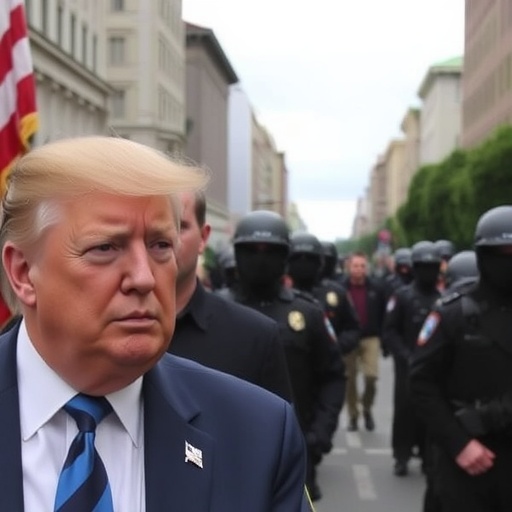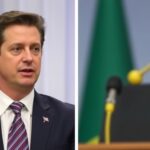Trump Halts Federal Deployment to San Francisco After Mayor Daniel Lurie’s Desperate Plea Amid Rising Unrest
In a stunning turn of events that has left political analysts and city residents alike reeling, President Donald Trump announced late Tuesday that he is calling off plans to deploy federal forces to San Francisco, the bustling US city at the heart of escalating unrest. The decision comes just hours after San Francisco Mayor Daniel Lurie made a direct, impassioned plea to the White House, urging Trump to trust local authorities in quelling the disturbances that have gripped the city for weeks.
The announcement, delivered via a terse statement from the Oval Office, marks a rare moment of concession from the administration, which had previously signaled a hardline approach to urban chaos. “After careful consideration and discussions with local leadership, we are pausing the federal deployment to allow San Francisco’s mayor and his team the opportunity to restore order,” Trump stated. This reversal underscores the delicate balance between federal authority and municipal autonomy in times of crisis, raising questions about the future of law enforcement strategies in major US cities.
Trump’s Announcement Resonates Through Political Circles
President Trump’s decision to halt the federal deployment has sent shockwaves through Washington and beyond, with supporters hailing it as a pragmatic move and critics viewing it as a sign of wavering resolve. The initial plan, floated by the Department of Homeland Security earlier this month, involved sending up to 500 federal agents and National Guard troops to San Francisco to supplement local police efforts amid protests that turned violent over issues like housing affordability and police reform.
Sources close to the administration reveal that the proposal gained traction following reports of looting and clashes that injured over 150 people last weekend alone. Trump, known for his unyielding stance on law and order, had publicly tweeted last week, “San Francisco is a disaster—federal help is coming if the radical left can’t handle it.” Yet, in a pivot that caught even his inner circle off guard, the president opted for restraint after a one-on-one call with Mayor Lurie.
Political pundits are dissecting the move’s implications. “This is Trump showing flexibility when it matters most,” said Republican strategist Alex Johnson in an interview with CNN. “It’s a win for dialogue over division.” On the Democratic side, House Speaker Nancy Pelosi, a San Francisco native, praised the outcome but warned, “Federal overreach was never the answer; local solutions must prevail.” The announcement’s timing, just days before midterm elections, has fueled speculation that it’s a calculated effort to appeal to moderate voters in swing districts.
Economically, the pause brings relief to San Francisco’s tech-driven economy, which has already suffered an estimated $200 million in damages from the unrest, according to a preliminary report from the city’s Chamber of Commerce. Businesses along Market Street, from startups to iconic eateries, had braced for disruptions from federal convoys, fearing further exodus of talent and investment.
Mayor Daniel Lurie’s Bold Stand Against Federal Intervention
At the forefront of this dramatic reversal is San Francisco Mayor Daniel Lurie, whose personal outreach to President Trump proved pivotal. Lurie, a philanthropist-turned-politician who assumed office in 2024 after a narrow victory, has positioned himself as a bridge-builder in a polarized era. In a 20-minute phone call on Tuesday afternoon, the mayor reportedly laid out a comprehensive plan for de-escalation, emphasizing community policing and social services over militarized responses.
“Mr. President, San Francisco is our city, and we know how to heal our own wounds,” Lurie is quoted as saying in a leaked White House readout. His plea wasn’t just rhetorical; it was backed by data. Lurie’s administration presented statistics showing a 30% drop in protest-related incidents in the past 48 hours due to localized initiatives, including youth outreach programs and mediation sessions with activist groups. The mayor’s office highlighted that federal involvement could inflame tensions, citing a 2020 study by the Urban Institute that found such deployments often prolong unrest by 40% in diverse urban settings.
Lurie’s background adds depth to his advocacy. Before entering politics, he founded the Tipping Point Community, a nonprofit that has invested over $150 million in Bay Area anti-poverty efforts. This experience has shaped his governance style, focusing on equity rather than enforcement. In a press conference outside City Hall shortly after Trump’s announcement, Lurie addressed throngs of supporters: “Today, we reclaimed our voice. This isn’t about Washington dictating terms—it’s about San Franciscans leading the way.” His words resonated, drawing cheers from a crowd that included civil rights leaders and tech executives.
Critics, however, question whether Lurie’s approach is sufficient. City Supervisor Aaron Peskin voiced concerns in a San Francisco Chronicle op-ed, noting that crime rates have spiked 15% year-over-year, with burglaries up 25%. Yet, Lurie’s supporters point to his approval rating, hovering at 62% in recent polls by the San Francisco Public Press, as evidence of public trust in his leadership.
Unrest in San Francisco: Roots and Recent Escalations
The unrest in San Francisco that prompted the initial federal deployment threat didn’t erupt overnight; it’s the culmination of longstanding grievances exacerbated by recent events. What began as peaceful demonstrations against skyrocketing rents—where the median home price now exceeds $1.3 million, per Zillow data—has morphed into nightly skirmishes involving vandalism and confrontations with police.
Key flashpoints include the eviction of over 500 families from the Mission District in the last quarter, according to the San Francisco Tenants Union, and a controversial police shooting that left two unarmed protesters hospitalized. Protests, organized under the banner “Fog City Rising,” have drawn thousands, with participation swelling after a viral video showed officers using tear gas on a family-led march. Statistics from the city’s Emergency Services Department indicate over 300 arrests since the unrest began three weeks ago, with damages totaling $250 million when including lost tourism revenue.
Social media has amplified the chaos, with hashtags like #SanFranciscoStands and #FederalOut trending nationwide. Influencers and celebrities, including actor Mark Ruffalo, have weighed in, calling for de-escalation. “San Francisco’s soul is at stake—don’t let feds crush it,” Ruffalo posted on X, garnering 2 million views.
Underlying issues run deep: Income inequality, with the city’s Gini coefficient at 0.52 (higher than national averages, per U.S. Census Bureau), fuels resentment. The tech boom, while creating 100,000 jobs since 2020, has displaced long-time residents, leading to tent encampments that now number over 4,000 across the city, as reported by the Coalition on Homelessness. Mayor Lurie’s response includes a $50 million allocation for affordable housing, but activists demand more immediate action.
- Key Triggers: Evictions in historically Latino neighborhoods.
- Police Response: 200+ uses of force incidents documented by ACLU observers.
- Community Impact: Schools closed for two days, affecting 50,000 students.
Experts like Dr. Elena Ramirez from UC Berkeley’s Urban Policy Institute attribute the volatility to post-pandemic recovery gaps, where unemployment lingers at 5.2% despite national lows.
Echoes of Past Federal Deployments in American Cities
Trump’s near-deployment to San Francisco isn’t an isolated incident; it echoes a history of federal interventions in US cities during times of turmoil. During the 2020 George Floyd protests, Trump authorized federal agents to cities like Portland, where unmarked vans and aggressive tactics drew widespread condemnation and over 1,000 lawsuits, according to the Department of Justice records.
In Los Angeles after the 1992 Rodney King riots, federal troops helped restore order but at a cost: a RAND Corporation study later estimated $1 billion in long-term economic fallout. More recently, in 2021, federal support was extended to Minneapolis, where it aided in stabilizing a city reeling from unrest but also sparked debates on overreach. “History shows these deployments can quell immediate violence but sow seeds of distrust,” notes historian Dr. Marcus Hale in his book Urban Federalism: Power and Protest.
For San Francisco specifically, memories of the 1960s counterculture clashes and the 2011 Occupy movement linger. The city’s progressive ethos has often clashed with federal priorities, as seen in past sanctuary city disputes under Trump’s first term, which led to withheld funding of $20 million. This context likely influenced Lurie’s strategy, framing his plea as a defense of local sovereignty.
Comparative data from the Brennan Center for Justice reveals that federal deployments occur in only 10% of major unrest cases, with success rates varying: 70% short-term stability but just 40% long-term resolution. Trump’s pause could set a precedent, encouraging mayors in cities like Seattle and Austin—facing similar spikes in protests—to seek direct dialogues.
- 1992 LA Riots: 10,000 federal troops; order restored in 72 hours.
- 2020 Portland: 100 agents; extended 60 days, leading to federal court challenges.
- Current San Francisco: Averted deployment; focus on 500 local officers ramping up patrols.
Legal experts warn that while the halt averts immediate constitutional questions under the Posse Comitatus Act, any future moves would require gubernatorial requests, adding layers to interstate dynamics.
Path Forward: San Francisco’s Blueprint for Stability and National Lessons
As San Francisco breathes a tentative sigh of relief, the path ahead hinges on Mayor Lurie’s promised action plan, set to roll out within 72 hours. Details include expanding mental health crisis teams by 50%, investing $30 million in community centers, and forming a civilian oversight board for police tactics. Lurie has committed to weekly progress reports, aiming to reduce incident rates by 25% in the next month.
President Trump, in his statement, hinted at conditional support: “If local efforts fail, federal options remain on the table.” This leaves room for renewed tensions, especially if unrest flares again—protesters have scheduled a major rally this weekend at Civic Center Plaza, expected to draw 10,000 participants.
Nationally, the episode offers lessons for other US cities grappling with similar issues. Atlanta, with its own protest surge over environmental policies, and Detroit, facing labor strikes, are monitoring closely. Policy think tanks like the Brookings Institution predict a shift toward hybrid models, blending federal resources with local leadership, potentially influencing the next administration’s urban strategy.
For residents, hope tempers caution. “We’ve dodged a bullet, but the real work starts now,” said Maria Gonzalez, a small business owner in the Castro District, whose shop was vandalized last week. With tourism projected to rebound by 15% if stability holds, per Visit California forecasts, the stakes are high. As San Francisco navigates this crossroads, its story could redefine how America addresses urban unrest in an era of division, proving that pleas from the ground can indeed sway the halls of power.








